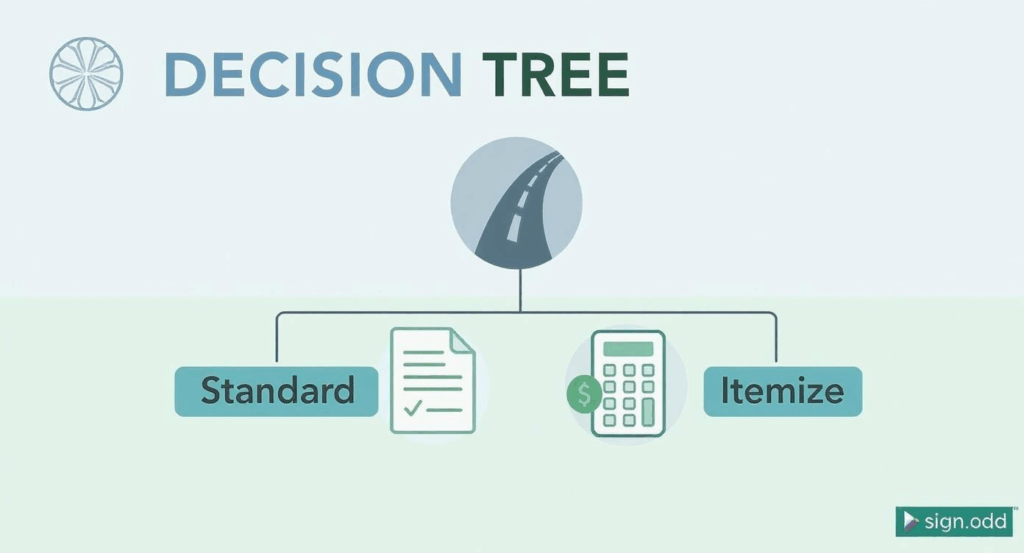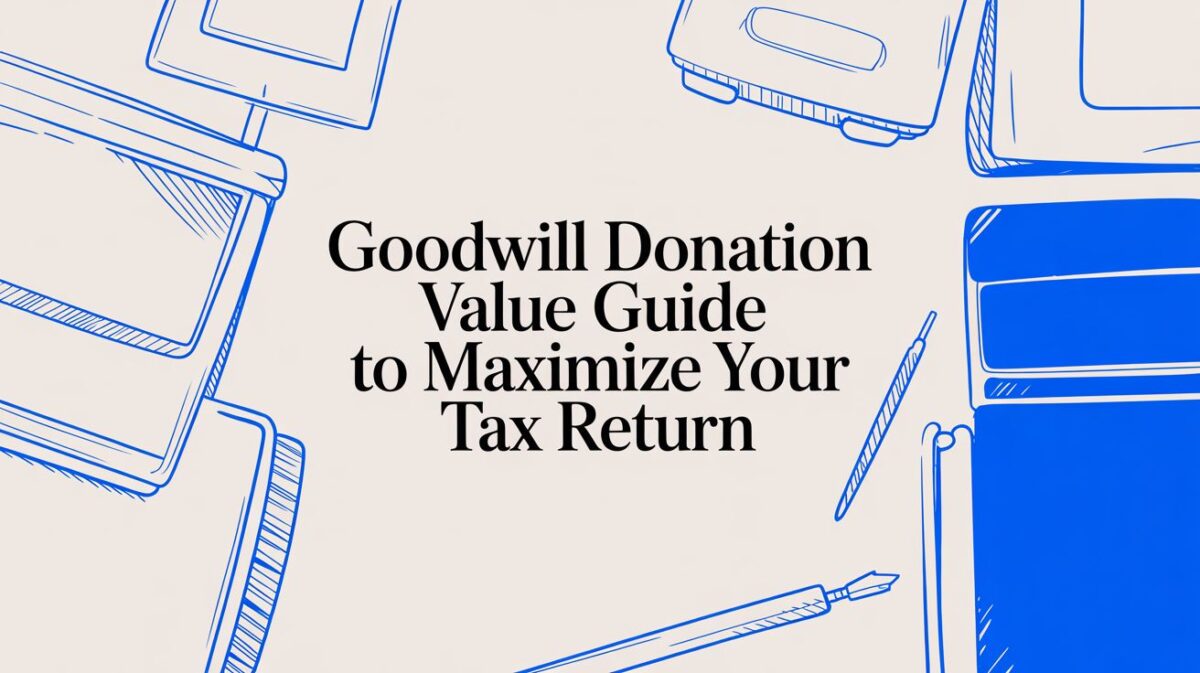How to Maximize Your Tax Deductions: A Practical Guide
Lowering your tax bill isn’t about uncovering some secret loophole. It’s about smart, consistent financial habits you build throughout the year. The biggest key to maximizing your deductions often boils down to a single choice: take the simple standard deduction, or itemize your expenses?
For a growing number of people, it’s the carefully tracked charitable donations that tip the scales, making itemizing the clear winner.
Your Path to Smarter Tax Savings
Forget the frantic scramble for receipts come April. A proactive approach turns tax season from a chore into a real opportunity to save money. It all starts with understanding your deductions and having a simple system to document them. This guide gives you a clear roadmap to take control of your deductions, starting with the most important decision you’ll make.
The first step is always weighing the standard deduction against what you could itemize. It’s simple math, really. If your itemized expenses add up to more than the standard deduction for your filing status, you should itemize.
The Power of Charitable Giving
While things like mortgage interest, medical bills, and state and local taxes (SALT) are big players, your charitable contributions are often the most flexible and controllable part of the equation.
Every bag of clothes, every old piece of furniture, every box of household goods you drop off at a qualified charity has a value you can deduct. The problem? Most people either forget to track these non-cash donations or have no idea how to value them. The result is thousands of dollars in potential deductions left on the table every year.
This is where a little discipline pays off big. When you treat your charitable giving with the same care as your other financial records, you can often close the gap between the standard deduction and a much larger itemized total.
Looking Ahead: The SALT Cap Is Changing
There’s an important update regarding the State and Local Tax (SALT) deduction that affects homeowners in high-tax states. The One Big Beautiful Bill Act of July 2025 temporarily increased the SALT deduction cap from $10,000 to $40,000 for tax years 2025 through 2029. This change significantly impacts residents in states like New York, California, New Jersey, and Connecticut by allowing a larger portion of state income and property taxes to be deducted.
Previously, the $10,000 cap, part of the Tax Cuts and Jobs Act of 2017, limited deductions significantly. With the new cap, homeowners can now deduct up to $40,000, providing substantial relief and potentially reducing taxable income. This adjustment may lead many taxpayers to reconsider itemizing their deductions, especially when combined with other items like mortgage interest and charitable contributions.
For optimal deduction management, an organized system is essential. Tools like DeductAble simplify the process by accurately tracking donations and generating necessary reports for tax time. This ensures every contribution is properly documented and valued, reflecting true generosity in tax filings. Given the complexity of new tax provisions, consulting a tax advisor is advisable, especially for those with higher incomes, to determine the best approach for maximizing tax savings.
Standard vs. Itemized Deductions: Which Is Right for You?
Every tax season, you face a big decision that directly hits your wallet: should you take the easy standard deduction, or should you do the legwork to itemize your expenses? This choice is the absolute first step in figuring out how to maximize your tax deductions.
For a lot of people, the standard deduction is the way to go. It’s a simple, no-fuss flat amount you subtract from your income. But if your actual deductible expenses add up to more than that standard amount, you’re literally leaving money on the table by not itemizing.
This decision tree breaks down the core choice you’ll make.

As you can see, it all boils down to a simple math problem: do your specific expenses beat the government’s set amount for your filing status?
The Building Blocks of Itemized Deductions
So, what are these expenses that could push you over the top? Most itemizers rely on four main categories. Getting a handle on these is the key to making a smart choice.
- Mortgage Interest: This is the big one for most homeowners. The interest you pay on your home loan can be substantial, often forming the foundation of your itemized total.
- State and Local Taxes (SALT): This bucket includes your property taxes and either your state income taxes or sales taxes. Recently, the SALT cap was increased from $10,000 to $40,000 for tax years 2025 through 2029, significantly affecting those who itemize deductions, especially in high-tax states.
- Medical and Dental Expenses: Here’s a tricky one. You can only deduct unreimbursed medical costs that are more than 7.5% of your adjusted gross income (AGI). That’s a high bar, but a major surgery or ongoing health issue can put you over it fast.
- Charitable Contributions: This is where you have the most control. For many, it’s the final push that makes itemizing worthwhile. It covers cash donations and the Fair Market Value (FMV) of all those goods you donate—clothing, furniture, household items, you name it.
To help you see the differences more clearly, here’s a quick comparison.
Standard Deduction vs Itemized Deductions at a Glance
This table offers a snapshot to help you decide which path might be better for your financial situation.
| Feature | Standard Deduction | Itemized Deductions |
|---|---|---|
| Simplicity | Very simple. A fixed dollar amount based on filing status. | More complex. Requires tracking and documenting specific expenses. |
| Recordkeeping | Minimal. No need to save receipts for individual expenses. | Extensive. Requires detailed records for all claimed deductions. |
| Who It’s For | Renters, taxpayers with few deductible expenses, or those who prefer simplicity. | Homeowners, high earners in high-tax states, the very charitable, or those with large medical bills. |
| Potential Savings | Capped at the standard amount. Predictable but limited. | Unlimited potential. The more you can legally deduct, the more you can save. |
Ultimately, the goal is to choose the method that results in the lowest taxable income. For a deeper dive into this crucial decision, you can check out our complete guide on the itemized deduction vs standard deduction.
How Small Donations Make a Big Difference
Let’s run a quick scenario. Say you’re a new homeowner. Your mortgage interest and property taxes get you close to the standard deduction, but not quite there. You might be tempted to just take the standard and call it a day.
But what about the five bags of clothes you donated after spring cleaning? Or that old couch you gave to a local charity? And all those kitchen supplies you dropped off at the shelter?
This is where tracking becomes a powerful financial tool. So many people write off their non-cash donations as just “getting rid of clutter,” completely underestimating their value. In reality, every single donated item has a deductible value. When you get in the habit of logging these contributions, the numbers add up faster than you’d think.
That’s exactly why we built DeductAble. You can quickly log what you’ve donated, and it helps you assign a fair, IRS-compliant value, creating a clean report. It transforms a pile of stuff in your garage into a significant deduction that can easily make itemizing the smarter move.
A Look Ahead at SALT Tax Changes
There is a significant change the year that makes itemizing a straightforward choice for millions, particularly homeowners in states with high taxes. The previous $10,000 cap on the State and Local Tax (SALT) deduction has been temporarily increased to $40,000 for tax years 2025 through 2029, following the enactment of the One Big Beautiful Bill Act in July 2025.
If this increased cap remains or is adjusted further, many taxpayers who previously hovered just below the itemizing threshold will easily surpass it based on state and local taxes alone.
This underscores the importance of tracking all potential deductions now. Establishing a habit of documenting charitable contributions today will position you to fully benefit from these changes and optimize your savings in the future.
Mastering Charitable Donations for Maximum Impact
Giving to charity is one of the best ways to support your community, but it’s also a powerful tool for lowering your tax bill. To get the most out of your generosity, you need to understand the IRS rules for both cash and non-cash contributions. This isn’t just about writing a check; it’s about careful documentation and knowing how to value everything you give away.
First things first: you can only deduct contributions made to a qualified organization. Think 501(c)(3) groups—churches, nonprofit schools and hospitals, and major charities. Gifts to your neighbor or a political campaign, no matter how noble the cause, won’t count on your tax return.

Valuing Your Non-Cash Donations Correctly
This is where so many people leave money on the table. Every bag of clothes, piece of furniture, or box of kitchen gadgets has a deductible value. The IRS expects you to determine the Fair Market Value (FMV) for these items—basically, what someone would realistically pay for them in their current state.
Pulling numbers out of thin air is a huge red flag for the IRS. A designer suit in great shape is worth a lot more than a faded t-shirt, and it’s your job to make that distinction. Your valuation has to be reasonable and something you can defend if asked.
That’s exactly why we built DeductAble. It takes the guesswork out of valuing your donated goods. You can log each item in seconds, and the app helps you assign a fair, appropriate value. It turns a chore into a simple process and creates the detailed report you need to back up your deductions.
The AGI Limits on Charitable Giving
While the government encourages giving, there are caps on how much you can deduct in a single year. These limits are based on your Adjusted Gross Income (AGI), and knowing them is key to smart tax planning.
- Cash Contributions: You can generally deduct cash gifts up to 60% of your AGI.
- Non-Cash (Ordinary Income Property): For everyday items like clothes and household goods, the limit is usually 50% of your AGI.
- Non-Cash (Capital Gain Property): If you’re donating appreciated assets like stocks, the cap is typically 30% of your AGI.
What Happens If You Give More Than the Limit?
Don’t worry, your extra generosity isn’t lost. The IRS allows you to carry over any excess contributions for up to five future tax years. This is a fantastic planning tool that lets a single big donation provide tax benefits for years to come.
This is just scratching the surface. For a deeper dive, check out our guide on what donations are tax deductible to make sure you’re not missing anything.
Beyond Cash and Clutter: Donating Appreciated Assets
One of the smartest tax strategies out there involves donating appreciated assets, like stocks or mutual funds you’ve owned for more than a year. The tax benefits here are twofold and incredibly powerful.
First, you get to deduct the asset’s full fair market value on the day you donate it. Second—and this is the big one—you completely sidestep the capital gains tax you would have paid if you’d sold it first. This means more money goes to the charity and less to the government.
Let’s break it down with an example:
Scenario: Donating Appreciated Stock
You own stock now worth $10,000 that you bought years ago for $2,000.
- Option 1: Sell Then Donate. You’d first owe capital gains tax on your $8,000 profit. At a 15% rate, that’s a $1,200 tax bill. You’re left with just $8,800 to give to the charity.
- Option 2: Donate the Stock Directly. You transfer the shares straight to the charity. You get a full $10,000 tax deduction, and you pay $0 in capital gains tax. The charity gets more, and so do you.
The Future of Deductions: SALT Changes on the Horizon
In 2025, a significant change in tax law is set to occur, potentially making itemizing deductions, such as charitable contributions, more appealing for many homeowners. The One Big Beautiful Bill Act, enacted in July 2025, temporarily increased the State and Local Tax (SALT) deduction cap from $10,000 to $40,000 for tax years 2025 through 2029. This adjustment notably impacts taxpayers in high-tax states, influencing their choice to itemize deductions.
The original $10,000 limit was established by the Tax Cuts and Jobs Act of 2017, effective from 2018 to 2024. The current cap, now $40,000 for single filers and married couples filing jointly, with a phaseout starting at a modified adjusted gross income above $500,000, provides substantial relief to affected homeowners. For instance, a taxpayer who previously could only deduct $10,000 on their federal return can now potentially deduct up to $40,000, significantly lowering taxable income.
This new cap may encourage more taxpayers to itemize deductions, especially if their total itemized deductions exceed the standard deduction. As the tax landscape becomes more complex, consulting a tax professional is advisable to navigate the potential benefits and intricacies of these changes.
Strategic Timing: The Art of Bunching Deductions
Ever feel like you’re stuck in a tax deduction no-man’s-land? One year, your itemized deductions are just shy of the standard deduction. The next, you’re barely over. It’s a common frustration, but there’s a powerful way to take back control: strategic timing.
The technique is called bunching, and it’s all about concentrating your deductible expenses into a single tax year. Instead of spreading your donations or other controllable expenses out, you “bunch” them into one year to sail past the standard deduction. The following year? You simply take the easy route with the standard deduction. This simple back-and-forth strategy can unlock thousands in extra deductions over a two-year cycle.

Putting Bunching into Practice
So, how does this actually work? It’s simpler than it sounds and hinges on expenses where you control the payment date.
Here are the most common plays for bunching:
- Charitable Donations: This is the easiest and most effective lever to pull. You can simply make two years’ worth of your planned contributions in a single calendar year. A big donation in December can make all the difference.
- Property Taxes: Depending on where you live, you might be able to prepay property taxes that are due early next year. Paying your January bill a few weeks early in December shifts that deduction into the current tax year.
- Medical Expenses: You can often schedule elective procedures or buy necessary medical equipment toward the end of the year to concentrate those costs.
A Real-World Example:
Let’s say the standard deduction for a married couple is $29,200. Your family typically has around $28,000 in itemized deductions each year ($10,000 in state/local taxes, $12,000 in mortgage interest, and $6,000 in charitable giving). Normally, you’d just take the standard deduction and call it a day.With bunching, you could donate $12,000 this December (covering this year’s $6,000 plus next year’s). That one move pushes your itemized total to $34,000. You’d itemize this year and then take the $29,200 standard deduction next year.
The result? Over two years, your total deductions are $63,200 ($34,000 + $29,200). That’s a huge jump from the $58,400 you’d get by taking the standard deduction both years.
This kind of forward-thinking requires a little planning. This is where DeductAble really shines. It lets you see your charitable giving pile up in real-time, so you can easily decide in November or December if bunching makes sense. A simple timing shift can turn into substantial savings.
The Bigger Picture of Strategic Tax Planning
This isn’t just a trick for individual taxpayers; it’s a core principle of tax planning for everyone, including massive corporations.
Think about the 2017 Tax Cuts and Jobs Act. It introduced complex rules like the Foreign-Derived Intangible Income (FDII) and Global Intangible Low-Taxed Income (GILTI) deductions. These created enormous incentives for companies to strategically time when and where they recognized income and expenses around the globe.
In fact, the Section 250 deduction, which governs these incentives, reached an eye-watering $517 billion in 2022. It’s a powerful reminder of how timing and structure can slash a tax bill, whether it’s for a family or a Fortune 500 company. You can see the full breakdown of these large-scale international tax reforms from the Wharton Budget Model.
SALT Cap Changes and Their Impact on Your Taxes
Significant changes to the State and Local Tax (SALT) deduction are currently affecting taxpayers, especially homeowners in high-tax states. As of July 2025, the One Big Beautiful Bill Act has temporarily increased the SALT cap from $10,000 to $40,000 for tax years 2025 through 2029. This adjustment is crucial for many who itemize deductions.
Changes in the SALT Cap
Initially established by the Tax Cuts and Jobs Act (TCJA) of 2017, the $10,000 SALT cap was in place from 2018 to 2024. Under the new legislation, the cap is $40,000 for single filers, heads of household, and married couples filing jointly, and $20,000 for married individuals filing separately. However, for taxpayers with modified adjusted gross incomes (MAGI) above $500,000 ($250,000 for married filing separately), the full deduction phases out. This cap is set to revert to $10,000 in 2030 unless further action is taken by Congress.
Impact on High-Tax State Homeowners
In states such as New York, California, New Jersey, and Connecticut, where state income and property taxes often exceed previous limits, the increased cap offers substantial relief. For example, a homeowner paying $40,000 in total state and local taxes can now deduct the full amount, potentially reducing their taxable income by an additional $30,000.
Itemizing Deductions
The original cap, combined with an increased standard deduction, led to a reduction in the number of taxpayers itemizing deductions. Now, with the $40,000 cap, the dynamics have shifted. Taxpayers whose total deductions, including the higher SALT amount, exceed the standard deduction might find itemizing more beneficial.
Professional Advice
Due to the complexity of the new provisions, including income phaseouts and interactions with other tax regulations, consulting a tax advisor is advisable for those with high incomes to determine the best strategy for maximizing tax savings.
Your Deduction Maximization Checklist
Alright, let’s move from the “what” and “why” to the “how.” Turning your good intentions into actual tax savings comes down to a consistent, organized approach. This isn’t just a list; it’s a practical game plan to make sure no detail gets missed when it’s time to file.
First things first: documentation is everything. You need to gather every single receipt and acknowledgment from the charities you’ve supported throughout the year. For any single donation—cash or non-cash—worth $250 or more, the IRS requires a formal written acknowledgment from the organization. No exceptions.
Confidently Valuing and Finalizing
With your cash donations sorted, it’s time to tackle your non-cash items. This is where most people leave money on the table. Go through your records and assign a reasonable Fair Market Value (FMV) to everything you gave, from that bag of clothes to the old bookshelf. Your valuations should honestly reflect each item’s age and condition, and having a consistent method is your best defense if the IRS ever asks questions.
This is where DeductAble really shines, especially when you use it all year long. Instead of scrambling and guessing in April, you get a clean, organized report ready to go. If you’ve donated a big-ticket item, the rules can get a bit more specific. We break it all down in our guide on donating your car to charity.
Once you have all your potential deductions tallied up—charitable gifts, mortgage interest, and SALT payments—you’re at the final decision point. Compare your total itemized figure against the standard deduction for your filing status. It’s a simple calculation: pick the one that saves you more money.
Following this process eases the stress of tax season. By establishing a habit of tracking now, you’re preparing for a smoother and potentially more rewarding filing experience next year. With the SALT cap increased to $40,000 due to the One Big Beautiful Bill Act, this meticulous record-keeping is even more valuable, especially for homeowners in high-tax states aiming to maximize deductions. This change, effective from 2025 through 2029, impacts the decision to itemize, as it allows deductions up to $40,000, significantly affecting homeowners in states like New York, California, New Jersey, and Connecticut.
Ready to stop guessing and start tracking your donations with confidence? Download DeductAble to turn your generosity into organized, valuable tax deductions. Get started at https://deductable.ai.




